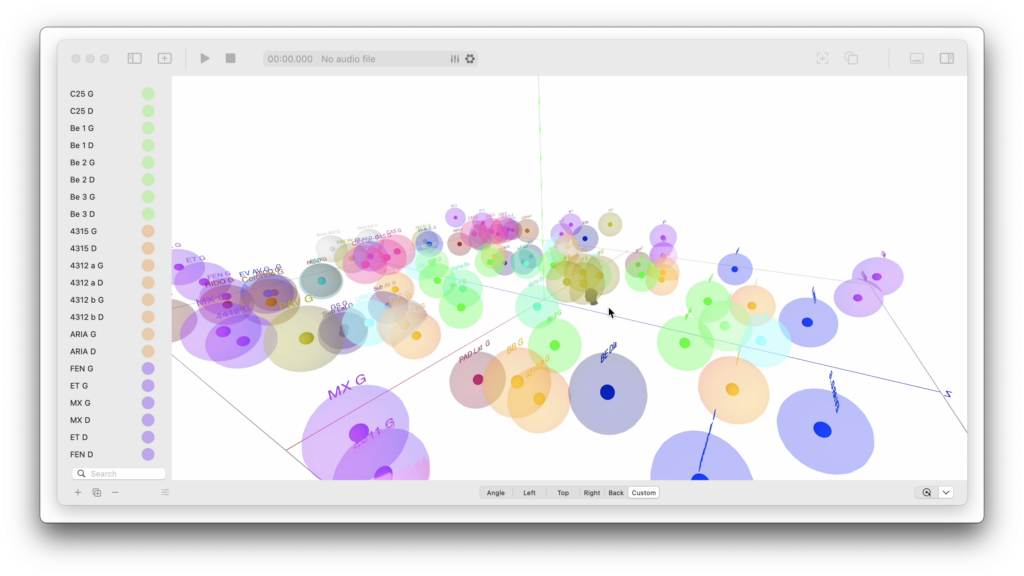
Documentation, Analyses and Models of Loudspeaker Orchestras: The Acousmonium as a Case Study
- On 3 novembre 2024
Conférence donnée avec Nathanaëlle Raboisson à l’Université libre de Berlin le 30 novembre 2024.
Renseignements : https://www.geisteswissenschaften.fu-berlin.de/we07/musik/veranstaltungen/Symposium_2024_11_29.html

Abstract
In 2015, we began a research project on the recording, analysis and archiving of acousmatic music performance (acousmatique.hypotheses.org) on speaker orchestra (acousmonium). This project is jointly supported by Paris-Saclay University and the Motus musical ensemble. We have developed a multi-modal recording device (Couprie and Raboissson 2017), proposed a classification system for gestures on the diffusion console, and established a methodology for comparing interpretations (Couprie and Raboissson 2022). We are currently creating a Heurist database that will include information and data about more than 800 different interpretations. This database will also eventually enable interpretations to be visualized.
In 2020, our research group collaborated with the Lutheries – Acoustique – Musique (LAM) team at the Institut Jean le Rond d’Alembert (Sorbonne University) and the Musidanse laboratory (Université Paris 8) to develop a virtual reality acousmonium (Webster, Raboisson et al. 2020). This first experiment enabled us to refine the analysis of spatial gestures and sound layers generated by the acousmonium, adapting its physical implementation for use in a virtual environment.
Since 2024, a new phase of the project has begun, with a detailed study of the acousmonium, the instrument for the interpretation of fixed music. This phase builds on the results of the experiment conducted in 2020 with the acousmonium in virtual reality. Its aim is to create a technical and musical model of the instrument. Initially, we have decided to focus on three aspects: establishing a framework for a multimodal documentation, building a semantic ontology and producing a 3D image and audio model of the instrument’s installation.
Initial work at the Futura 2024 festival has offered us a framework for detailed documentation of the instrument, both in technical terms (the devices and their connections) and in terms of its musical adaptation to each concert (the choice and positioning of speakers). This documentation will include both technical data sheets and pictures or 360° videos taken during rehearsals, and will be integrated into the database currently under construction. Instrument settings (tuning) have yet to be modeled to complete this documentation.
The development of a semantic ontology based on the CIDOC-CRM standard will eventually make it possible to describe different types of loudspeaker orchestras, completing multimodal documentation. Use of the CIDOC-CRM standard will ensure interoperability with other electronic musical instrument databases, and facilitate data preservation.
Finally, we have also started developing a 3D image and audio model of the loudspeaker layout in the MotusLabTool (github.com/pierrecouprie/MotusLabTool) and iAnalyse (logiciels.pierrecouprie.fr/?page_id=1796) software packages, which we use for recording and analyzing performances. The aim is to offer a simulation tool for musicologists and performers. Even if the rendering remains far from the concert experience, 3D modeling remains an ideal tool for completing documentation and aiding data analysis.
Our presentation will focus on these three aspects, presenting the challenges and difficulties involved in creating acousmonium documentation. The development of a semantic ontology to describe the instrument, or the creation of a 3D model, are to be considered both as tools for elaborating the documentation model, and as a method in digital musicology (Couprie 2023) for analyzing the instrument. The stakes go far beyond the practice of acousmatic music, since the aim is also to lay the foundations for a documentation method for modular electronic musical instruments, whose multiple arrangements still elude musical analysis.



0 Commentaires